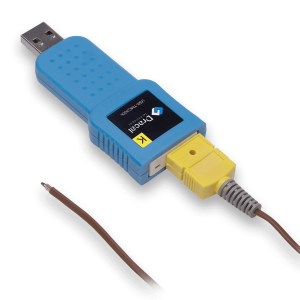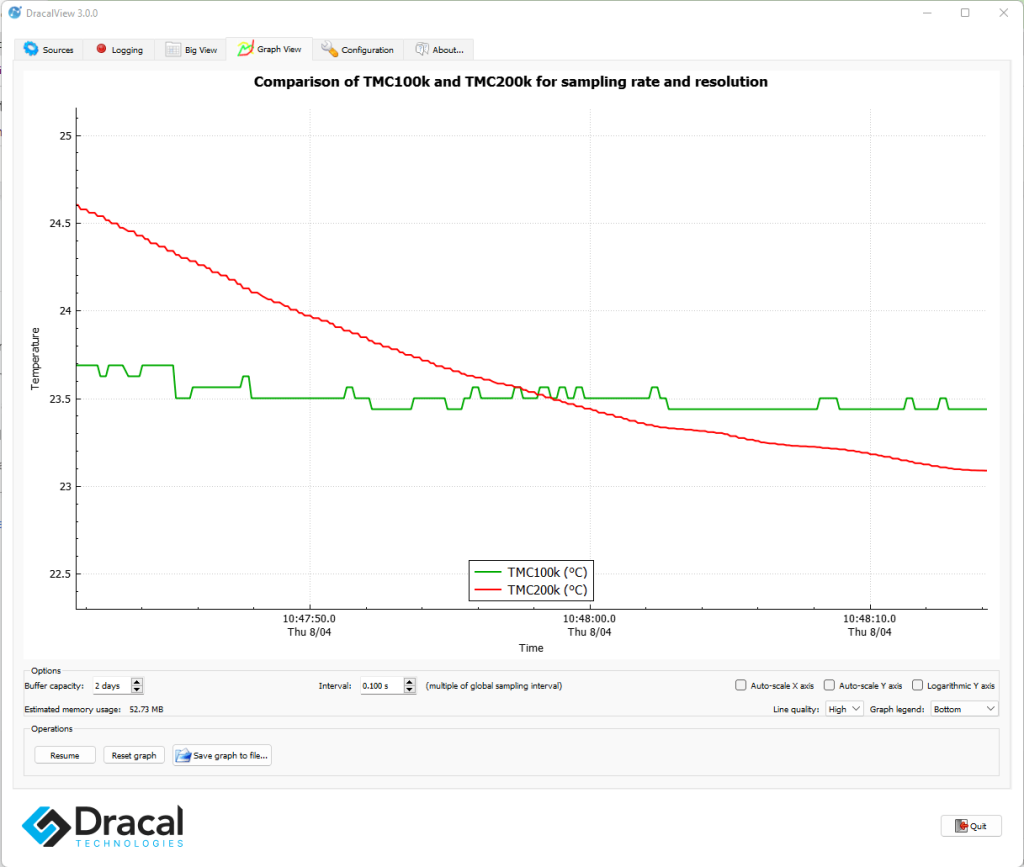How to log temperature data from a type K thermocouple in less than 3 minutes?

You need to precisely measure the temperature of a compound or unit in a closed vessel and the thermocouple seems to be the right sensor for the job. There is only one step left: generate the temperature data. But how to do it?
How does a thermocouple work?
A thermocouple combines two different conductive metals in two junctions: cold and hot. An electrical potential change is generated at the hot junction when the temperature changes. If you want to learn more about thermocouples, you can read this article.
We are therefore talking about measuring electrical potential, which must then be converted into temperature.
How to obtain temperature measurements?
The missing link between you and the thermocouple is the element that not only converts potential to temperature but also communicates the result to you in an understandable and accessible way. You need an adapter.
Adapters are either battery-operated or wired. An adapter can return the temperature value directly via an LCD display (like this configurable model from Cole-Parmer) or via software. The software is responsible for displaying the data and may or may not allow it to be stored, or even integrated into an existing system.
What solution does Dracal offer?
Through its TMC series of products, Dracal Technologies offers USB adapters under this second regime, whose free software solution is available here. Not only does it allow you to access your data instantly, without any configuration, but it also gives you access to a complete data acquisition (usb DAQ) and integration system for free.
Briefly, the advantages of the Dracal Technologies USB data acquisition and integration system are:
- Robust wired electrical connectivity between the probe and the data logger
- Sampling rate of up to 10 Hz (10 readings per second)
- The ability to mix and match data from different devices
- The ability to integrate data from Dracal measurement devices into your existing systems via the command line tools
To learn more about the differences between a data acquisition system and a simple data logger, see our article: Datalogger or Data Acquisition System: What Is the Difference?
Type K thermocouple: is this the right one for me?
The type K thermocouple is the most commonly used probe since it allows measuring the temperature in a wide range, while having a precision in the average of the other types of thermocouple.
Thermocouple type |
Temperature interval of the Dracal Technologies probe* |
Probe precision |
Dracal Technologies USB adapter precision (junction at 25°C) |
Whole instrument global precision (probe and Dracal adapter) |
| Type T | -73°C to 260°C | ±1°C | ±0.5°C | ±1.5°C |
| Type J | 0°C to 260°C | ±2.2°C | ±1.0°C | ±3.2°C |
| Type E | -73°C to 260°C | ±1.7°C | ±0.5°C | ±2.2°C |
| Type K | -73°C to 260°C | ±2.2°C | ±0.5°C | ±2.7°C |
| Type N | 0°C to 260°C | ±2.2°C | ±0.5°C | ±2.7°C |
*The probes offered by Dracal Technologies have a Teflon coated cable for additional protection, thus slightly limiting the usual temperature range of the thermocouple type.
In the table above, note that the total precision of the measuring instrument is the sum of the precision of the probe and the precision of the Dracal Technologies USB adapter.
If, upon reflection, type K is not the best fit for your needs, Dracal Technologies offers USB adapters for all of the thermocouple types listed in the table above. In Dracal's data acquisition solution, you can even have multiple thermocouples connected at the same time, and record their temperatures in a harmonized manner with the software package. Thermocouples can be of different types or even coupled to other types of Dracal measuring devices.
Choosing a Dracal adapter for type K thermocouples
Two USB adapters are compatible with type K thermocouples. The TMC100 series offers basic features such as a sampling rate of 3 Hz (3 readings per second) and a resolution of 0.0625°C. Note: resolution is the smallest observable change between two measurements. The TMC200 series offers better resolution, higher sampling rate and indication of various error statuses.
Feature |
TMC100k |
TMC200k |
| Operating range | -200°C to 1372°C | -200°C to 1372°C |
| Precision |
±0.5°C (housing <25°C) ±1.5°C (housing >25°C ) |
±0.5°C (housing <25°C) ±1.5°C (housing >25°C ) |
| Supported probe | Thermocouples type K (2 or 3 pins) | Thermocouples type K (2 or 3 pins) |
| Resolution | 0.0625°C | 0.00005°C |
| Sampling rate | 3 Hz | 5 Hz |
| Miscellaneous | Error status |
The following graph was generated using DracalView, Dracal Technologies' data acquisition system software. It first illustrates the difference between the resolution of the TMC100k and the TMC200k. Graphically, the resolution is shown by the height of the increment as the temperature varies. The quasi-smooth curve of the TMC200k shows that the temperature change is done in small steps. You may then notice that the requested sampling frequency is 10 Hz, but the adapters respond at their maximum speed. The sampling rate of the TMC200k, which is almost twice as high as that of the TMC100k, results in a much shorter time between readings.

In conclusion
In no time at all, you can record the temperature of a compound or a unit in a closed vessel using a Dracal Technologies Type K thermocouple and its USB adapter. Visit our thermocouple products page to find the solution that best suits you.
References:
Fraden, J. (2010). Handbook of Modern Sensors: Physics, Designs, and Applications. Netherlands: Springer New York.
Kraus, A. D., Bejan, A. (2003). Heat Transfer Handbook. UK: Wiley.